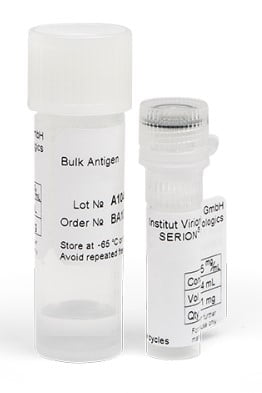| Weight | 1 lbs |
|---|---|
| Dimensions | 9 × 5 × 2 in |
| host | rabbit |
| isotype | IgG |
| clonality | polyclonal |
| concentration | 1 mg/mL |
| applications | ICC/IF, WB |
| reactivity | RAD17 |
| available sizes | 100 µg |
rabbit anti-RAD17 polyclonal antibody 3738
$376.00
Antibody summary
- Rabbit polyclonal to RAD17
- Suitable for: WB
- Isotype: Whole IgG
- 100 µg
rabbit anti-RAD17 polyclonal antibody 3738
| target relevance |
|---|
| Protein names Cell cycle checkpoint protein RAD17 (hRad17) (RF-C/activator 1 homolog) |
| Gene names RAD17,RAD17 R24L |
| Protein family Rad17/RAD24 family |
| Mass 77055Da |
| Function FUNCTION: Essential for sustained cell growth, maintenance of chromosomal stability, and ATR-dependent checkpoint activation upon DNA damage (PubMed:10208430, PubMed:11418864, PubMed:11687627, PubMed:11799063, PubMed:12672690, PubMed:14624239, PubMed:15235112). Has a weak ATPase activity required for binding to chromatin (PubMed:10208430, PubMed:11418864, PubMed:11687627, PubMed:11799063, PubMed:12672690, PubMed:14624239, PubMed:15235112). Participates in the recruitment of the 9-1-1 (RAD1-RAD9-HUS1) complex and RHNO1 onto chromatin, and in CHEK1 activation (PubMed:21659603). Involved in homologous recombination by mediating recruitment of the MRN complex to DNA damage sites (PubMed:24534091). May also serve as a sensor of DNA replication progression (PubMed:12578958, PubMed:14500819, PubMed:15538388). {ECO:0000269|PubMed:10208430, ECO:0000269|PubMed:11418864, ECO:0000269|PubMed:11687627, ECO:0000269|PubMed:11799063, ECO:0000269|PubMed:12578958, ECO:0000269|PubMed:12672690, ECO:0000269|PubMed:14500819, ECO:0000269|PubMed:14624239, ECO:0000269|PubMed:15235112, ECO:0000269|PubMed:15538388, ECO:0000269|PubMed:21659603, ECO:0000269|PubMed:24534091}. |
| Subellular location SUBCELLULAR LOCATION: Nucleus {ECO:0000269|PubMed:10232579, ECO:0000269|PubMed:10593953, ECO:0000269|PubMed:11799063, ECO:0000269|PubMed:12400013}. Chromosome {ECO:0000269|PubMed:24534091}. Note=Phosphorylated form redistributes to discrete nuclear foci upon DNA damage (PubMed:11799063). Localizes to DNA double-strand breaks (DSBs) (PubMed:24534091). {ECO:0000269|PubMed:11799063, ECO:0000269|PubMed:24534091}. |
| Tissues TISSUE SPECIFICITY: Overexpressed in various cancer cell lines and in colon carcinoma (at protein level). Isoform 2 and isoform 3 are the most abundant isoforms in non irradiated cells (at protein level). Ubiquitous at low levels. Highly expressed in testis, where it is expressed within the germinal epithelium of the seminiferous tubuli. Weakly expressed in seminomas (testicular tumors). {ECO:0000269|PubMed:10208430, ECO:0000269|PubMed:10232579, ECO:0000269|PubMed:10480350, ECO:0000269|PubMed:11602352, ECO:0000269|PubMed:9660800}. |
| Structure SUBUNIT: Part of a DNA-binding complex containing RFC2, RFC3, RFC4 and RFC5 (PubMed:10884395, PubMed:11572977, PubMed:11687627, PubMed:12400013, PubMed:14624239). Interacts with RAD1 and RAD9 within the 9-1-1 (RAD1-RAD9-HUS1) complex (PubMed:10884395, PubMed:11418864, PubMed:12578958, PubMed:36841485, PubMed:9660800). Interacts with RAD9B, POLE, SNU13 and MCM7 (PubMed:10593953, PubMed:14500819, PubMed:14611806, PubMed:15538388). DNA damage promotes interaction with ATR or ATM and disrupts interaction with the 9-1-1 (RAD1-RAD9-HUS1) complex (PubMed:10884395, PubMed:11418864, PubMed:12578958). Interacts (when phosphorylated) with NBN; promoting recruitment of the MRN complex to DNA damage sites (PubMed:24534091). {ECO:0000269|PubMed:10593953, ECO:0000269|PubMed:10884395, ECO:0000269|PubMed:11418864, ECO:0000269|PubMed:11572977, ECO:0000269|PubMed:11687627, ECO:0000269|PubMed:12400013, ECO:0000269|PubMed:12578958, ECO:0000269|PubMed:14500819, ECO:0000269|PubMed:14611806, ECO:0000269|PubMed:14624239, ECO:0000269|PubMed:15538388, ECO:0000269|PubMed:36841485, ECO:0000269|PubMed:9660800}. |
| Post-translational modification PTM: Phosphorylation on Ser-646 and Ser-656 is cell cycle-regulated, enhanced by genotoxic stress, and required for activation of checkpoint signaling (PubMed:11418864, PubMed:14500819, PubMed:14871926). Phosphorylation is mediated by ATR upon UV or replication arrest, whereas it may be mediated both by ATR and ATM upon ionizing radiation (PubMed:11418864, PubMed:11799063). Phosphorylation on both sites is required for interaction with RAD1 but dispensable for interaction with RFC3 or RFC4 (PubMed:11687627). Phosphorylation at Thr-633 by ATM in response to DNA damage promotes interaction with NBN and recruitment of the MRN complex to DNA damage sites (PubMed:24534091). {ECO:0000269|PubMed:11418864, ECO:0000269|PubMed:11687627, ECO:0000269|PubMed:11799063, ECO:0000269|PubMed:14500819, ECO:0000269|PubMed:14871926, ECO:0000269|PubMed:24534091}. |
| Target Relevance information above includes information from UniProt accession: O75943 |
| The UniProt Consortium |
Data
| No results found |
Publications
| pmid | title | authors | citation |
|---|---|---|---|
| We haven't added any publications to our database yet. | |||
Protocols
| relevant to this product |
|---|
| Western blot IHC ICC |
Documents
| # | SDS | Certificate | |
|---|---|---|---|
| Please enter your product and batch number here to retrieve product datasheet, SDS, and QC information. | |||
Only logged in customers who have purchased this product may leave a review.








Reviews
There are no reviews yet.